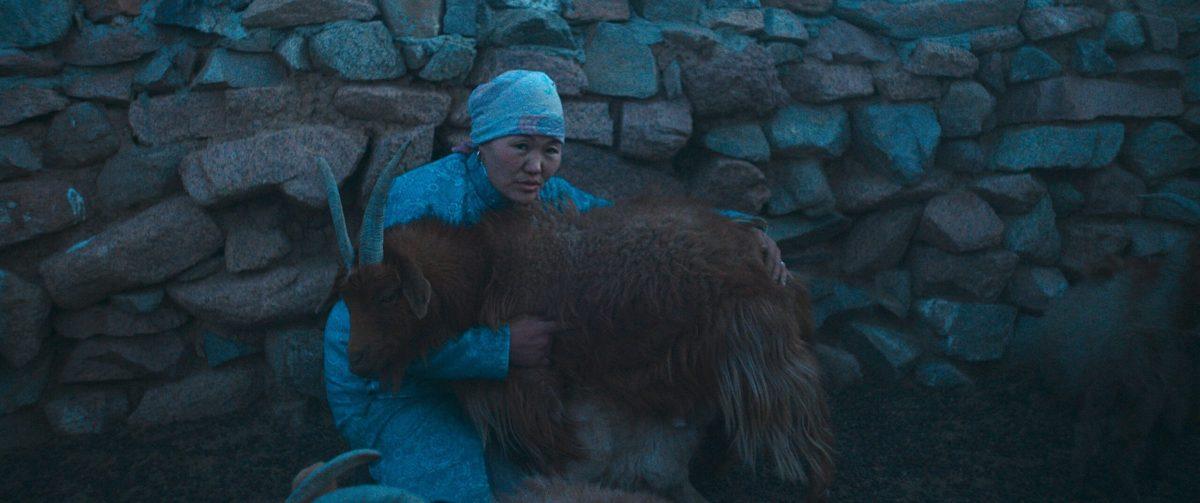
Gabrielle Brady’s “The Wolves Always Come at Night” follows a couple and their four children as they are uprooted from their home in the desert and experience change
In one of the earliest scenes in Gabrielle Brady’s “The Wolves Always Come At Night,” the subjects’ children sit around and share scary stories with a flashlight. One of the children begins with, “Let me tell you a story. I’m not sure if it’s real or not,” a meta-reference to the documentary’s hybrid format, where parts of it were documented in real-time while others were retroactively recorded. Brady then uses a sound bridge to juxtapose the child’s scary tale with a panning shot of the sweeping Gobi Desert they live in.
Producer Rita Walsh presented the film and answered questions from the audience after the screening on Saturday morning at the True/False Film Fest. The film follows Davaasuren Dagvasuren and Otgonzaya Dashzeveg and their four children as they navigate a tragic loss of their livestock and are forced to move and adjust to life in the city.
Brady defies traditional documentary expectations and blurs the line between documentary and fiction filmmaking by giving both Dagvasuren and Dashzeveg writing credits on the film. According to Walsh, production started on the documentary after the couple had already moved into the city, so they had to go back and recreate scenes of the family living in the Gobi desert. By giving the two main subjects writing credits, Brady gives the film a sense of realism and lets the couple have a large say in how their story is told.
In a scene reminiscent of a horror movie, Dagvasuren is awakened by the sound of his goats and goes to investigate with a flashlight. This suspenseful moment contributes to the fiction-documentary hybrid format by drawing upon other genres. Faced with the uncertainty of what Dagvasuren would find, the packed audience sat nearly still in fear for the family’s animals.
Shortly after this scene, Dagvasuren and Dashzeveg attend a meeting with others from the area and discuss the changing conditions. One attendee says that every other year, the spring season becomes harsh and nearly unbearable because of desertification – vegetation slowly drying up and disappearing. Without being too direct, Brady uses footage from the meeting to present the film’s theme: climate change and how it adds to the pressures people living in rural areas face. This gives the audience context as to why the desert is becoming uninhabitable.
The audience sees the pressure firsthand when the film smash cuts to a storm more severe than anything Dagvasuren has ever seen. This direct cut symbolizes the unpredictable nature of the Gobi Desert while provoking a sympathetic reaction from the audience. In a thrilling scene, the family scrambles to protect their herd of goats, before eventually opening the gates and releasing them to find cover from the storm.
In the emotional turning point of the documentary, Dagvasuren finds half of his herd dead in the desert after a long search. The audience seemed to sit in shock as he weaved through the corpses of his goats, feeling the pain with him. Dagvasuren and Dashzeveg sit in their home speechless, mourning the loss of their livestock. By using no music or dialogue in this scene, Brady invites the audience to sit in on this meeting and feel the weight of the loss with the couple.
Because of their loss, the couple decides they must move to the city, as they no longer have enough livestock to make a liveable income. During their journey, Brady captures the family driving past a herd of goats, visually signifying them leaving their old lives behind. Showing the family leaving what was so important to them brought about a murmur from the audience after spending half of the film building an emotional connection to the animals.
The rest of the film follows Dagvasuren and Dashzeveg struggling to adjust to an urban lifestyle, as they have to rebuild their home in the city and find jobs to support their family. In a scene parallel to the beginning of the film when Dagvasuren investigates his livestock, he goes outside in the middle of the night after hearing horses, only to find nothing. This moment shows the key theme of the film’s second half: the couple being haunted by memories of their past.
One of the film’s main conflicts comes about when Dagvasuren begins his new construction job, contributing to the very thing that drove him from the desert: climate change. The conflict provides a thought-provoking dilemma in which the audience is asked, “is it okay to drill” on land that hasn’t yet been drilled by humans?
The first half of the documentary is accompanied mostly by the sounds of the desert and howling wind, creating an immersive atmosphere for audiences. This is juxtaposed with the second half of the film, which uses somber, orchestral music to convey the struggle of simultaneously adjusting to a new lifestyle while mourning an old one. The shift in music clues audiences into the tonal change from hopeful to pensive while masterfully giving the film an emotionally uplifting ending.
Brady’s film is an excellently melancholic portrait of a family forced to begin a new life because of the devastating effects of climate change. Her hybrid-documentary format brings authenticity and emotion to the viewing experience while preserving the incredible story of Dagvasuraen and Dashzeveg.
You can keep up with The Maneater’s 2025 True/False Film Fest coverage here.
Edited by Faith Jacoby | [email protected]
Copy edited by Natalie Kientzy | [email protected]
Edited by Annie Goodykoontz | [email protected]